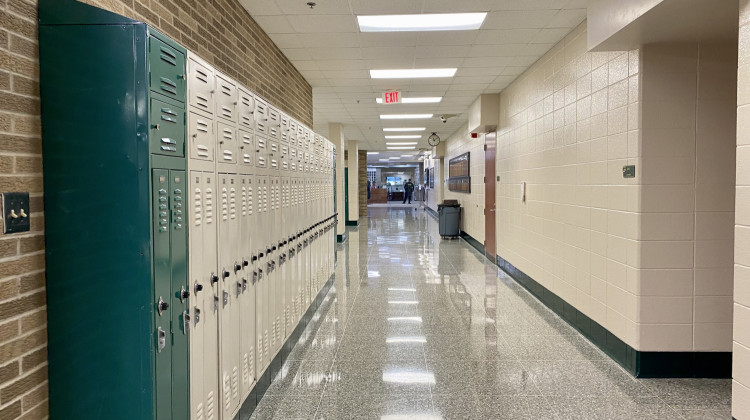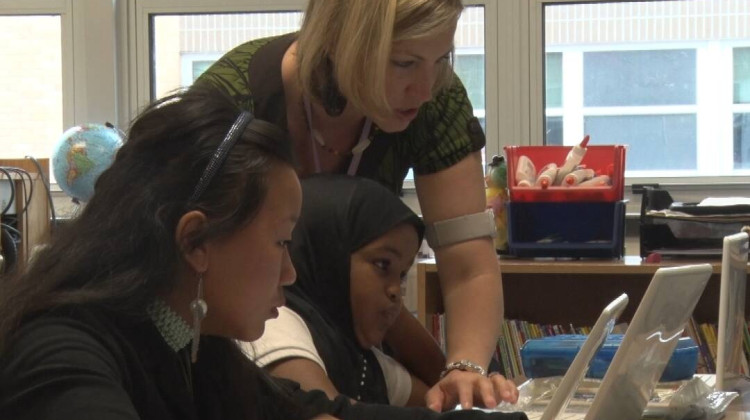
The final version of new high school graduation requirements mirrors some parts of current rules. But rather than earning diplomas like the Core 40, students will be able to earn seals after completing a base diploma.
File Photo: WFYIIndiana’s Class of 2029 will graduate with new high school diploma requirements after months of debate, three drafts and thousands of public comments.
A 2023 law tasked the State Board of Education with adopting new rules by the end of the year. The board unanimously voted Wednesday to approve a recently updated draft of the requirements, which are intended to promote work-based learning and apprenticeships.
“This is certainly a long time coming for the board,” Indiana’s Secretary of Education Katie Jenner said. “We have spent hours, hours and hours listening to the many comments and ideas, solutions from Hoosiers around our state. We absolutely we’re able to improve the draft from the original.”
The final version of new high school graduation requirements mirrors some parts of current rules. But rather than earning diplomas like the Core 40, students will be able to earn seals after completing a base diploma.
Those seals focus on college, joining the workforce or enlisting in the armed forces.
The Indiana Department of Education’s first draft of the diploma rules, shared in March, would have made drastic changes to how high schoolers learn in the state.
The department’s second draft unveiled in August was closer to the current rules but featured an honors and honors-plus option for students on each track.
Board member Scott Bess told WFYI that he was happy with the final requirements although the state’s first draft embraced innovation.
“I was a fan of the first iteration of it because I thought it did push the boundaries,” Bess said in an interview before Wednesday. “The communication and the stakeholder engagement prior to putting it out in the public was something…I would have pushed for more of that.”
Board member B.J. Watts said drafting the diplomas was “messy” work but he’s proud of where the board landed for students.
The Indiana State Teachers Association voiced support for the approved draft.
The current version shows “considerable” improvements, said Jerrell Blakeley, ISTA’s director of government, community, racial and social justice.
“Educator voices have clearly been heard,” Blakeley said. “And ISTA sincerely appreciates the progress on these elements of the proposal.”
What’s different with these diplomas?
Under this new diploma plan, a high school student has three potential paths.
They can pursue college and earn an “enrollment” seal, which signifies to higher education institutions that they're ready for the workload and rigor of college.
To earn this seal, a student is required to take world language classes and more social studies and math classes, earning a C grade or higher in all those classes and a cumulative B average.
These students must also receive Advanced Placement, International Baccalaureate or Cambridge credits, or they can complete at least six college credits or garner specific scores on the SAT or ACT standardized exams.
Students who want to jump right into a career after graduation can earn the "employment" seal. Students must complete 150 hours of work-based learning and pursue a credential, three career and technical education (CTE) courses, or a graduation plan approved by their school district.
Students who want to join military branches like the state’s National Guard or the U.S. Army can earn the "enlistment and service" seal.
These students can either complete a year of JROTC in high school or an introduction to public service course. In addition to other supportive requirements, students have to achieve a 31 or higher on the military enlistment exam called the ASVAB Career Exploration Program.
To qualify for both the enlistment and employment seals, students must have no more than three unexcused absences each year of high school.
The ‘honors plus’ seal
A student can go a step further to earn the "Honors Plus" seal by taking more difficult classes while meeting academic benchmarks, earning a credential, or completing work-based learning or public service work.
The honors enlistment seal plus would result in a student enrolling in college ROTC. A student on the enlistment pathway could earn this seal if they are admitted to a service academy, like the U.S. Naval Academy, complete 100 hours of public service, hold a leadership role in an activity, or participate in two seasons of a team-based sport.
The purpose of all these changes is to make high school more flexible, so students can try new things and find opportunities outside the classroom.
“If you're interested in engineering, you should take physics,” Jenner told WFYI. “If you're interested in being in healthcare, you should take anatomy and physiology. So really, that flexibility of coursework will be key.”
‘Leaving with currency’
Today’s students are required to take Algebra I, Geometry and Algebra II. The Class of 2029 will be required to take Algebra I, a personal finance course, and then their pick of four math credits after that. Those courses are meant to align with a student’s chosen path.
The state’s chronic absenteeism and dismal college-going rates led to the shifts in high school curriculum, Jenner said Wednesday.
“Student apathy is at an all time high in our country and in Indiana,” Jenner said.
Jenner said it’s important that students be able to change their minds on their post-graduation goals and pivot based on their updated interests.
The new diplomas now have a rule for students who might speed through the base diploma requirements. Any Indiana student who graduates early must have completed an Honors or Honors Plus seal.
Jenner said they don’t want students moving through high school and not finishing a credential, advanced classes, or an apprenticeship.
“That is not really what we want to see in Indiana,” Jenner said. “We want to make sure they leave with currency.”
Diploma requirements can start next year
High schools can begin to phase in the new requirements next school year. During that time, some districts will see students in the old model and others embarking on the redesign path.
The department does not have a definitive list of what schools will participate yet.
Rachel Fradette is WFYI's Statehouse education reporter. Contact Rachel at rfradette@wfyi.org.
 DONATE
DONATE







 Support WFYI. We can't do it without you.
Support WFYI. We can't do it without you.